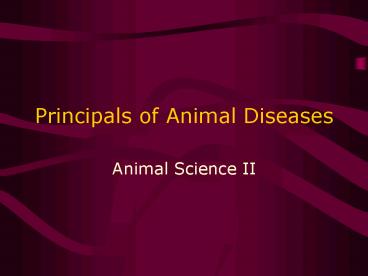Principals of Animal Diseases - PowerPoint PPT Presentation
1 / 28
Title:
Principals of Animal Diseases
Description:
Brucellosis. Abortions in last of pregnancy. Afterbirth retention. Sterility ... Brucellosis. Shipping Fever. Swine. Transmissible gastroenteritis (TGE) Virus ... – PowerPoint PPT presentation
Number of Views:349
Avg rating:3.0/5.0
Title: Principals of Animal Diseases
1
Principals of Animal Diseases
- Animal Science II
2
Causes
- Infectious
- Caused by microorganisms
- Noninfectious
- Faulty nutrition
- Metabolic disorder
- Trauma
- Toxic substance
- Congenital defects
- Birth defects
3
Cattle
- Brucellosis
- Abortions in last ½ of pregnancy
- Afterbirth retention
- Sterility
- Animal must be destroyed
- Shipping fever
- Coughing, diarrhea, fever, discharge
- Common in young animals
- Shipping stress
- Antibiotics and sulfa drugs
4
Brucellosis
5
Shipping Fever
6
Swine
- Transmissible gastroenteritis (TGE)
- Virus (highly contagious)
- 100 mortality in young pigs
- Vomiting, diarrhea
- White, yellow or green feces
- Drugs and vaccines not effective
- http//www.vet.purdue.edu/swine/neod.htm
7
TGE
8
Swine
- Pseudorabies
- Virus
- Fever, vomiting, convulsions, tremors
- Sudden death in young pigs 24hrs after symptoms
appear - Drugs and vaccines not effective
9
Pseudorabies
10
Swine
- Brucellosis
- Cholera (eradicated in the US)
- Scours
- Drugs for drinking water
- Leptospirosis
- MMA
- Mycoplasmal pneumonia
- SMEDI
- http//www.thepigsite.com/DiseaseInfo/
11
Poultry
- Aortic rupture
- Male turkeys
- 8 to 20 weeks
- Bleed to death
- Control
- Lower-energy ration
- Low-level use of tranquilizers
12
Poultry
- Newcastle
- Virus
- Gasping for air, sneezing, breathing difficulty,
tremors, paralysis - No known cure
- Avian pox (Fowl pox)
- Virus
- Yellow cankers in mouth and eyes
- Scabs around the head
- No known cure
13
Newcastle disease
14
Poultry
- Cocidiosis
- Controlled by coccidiostats
- Bluecomb
- Blackhead
- Fowl cholera
- Erysipelas
Antibiotics
15
Treatment
- Prevention is the best way to control diseases
- Cleanliness
- Vaccinations
- Quarantine
- Exposure
- Isolation
16
Parasites
- Objective
- Describe the internal and external parasites of
livestock and poultry
17
Parasites
- External
- Ticks
- bloodsuckers
- Mites
- mange
- Lice
- Biting bloodsuckers
18
Parasites
- External (continued)
- Blowfly
- Screwworm in larva stage
- Heel fly
- Cattle grub
- Horn fly
- Smallest, bloodsucking species
- Horsefly, housefly, stable fly
19
Parasites
- Internal
- Roundworms
- Stomach worms
- Ascarids
- Pinworms
- Bloodworms
- Lungworms
20
Parasites
- Internal (continued)
- Tapeworms
- Broad tapeworms
- Beef or pork tapeworm
- Flukes
21
Parasite Problems
- Weight loss and loss of gain
- Most costly excluding death
- Major external parasite of swine
- Lice and mites
- External parasites of poultry
- Lower production by sucking blood
22
Parasite Problems
- Heel Fly larva or Cattle grubs
- Greatest financial loss to cattle
- Lower rate of gain
- Damage hides and meat
23
Parasite Problems
- Major internal parasite of poultry
- Several types of worms
- Roundworm
- Most damage to hogs by internal parasites
24
Controlling Parasites
- Prevention
- Most effective
- Chemicals for external parasites
- Systematic insecticides that spread throughout
the body is most effective - Cattle grubs
25
Controlling Parasites
- Deworming pigs
- Sows and guilts one week befor farrowing
- Protects piglets
26
Controlling Parasites
- Poultry Houses
- Mites, bedbugs, fowl ticks hide in daylight
- Emerge at night
- Cracks and crevices must be sprayed
27
Controlling Parasites
- Poultry
- Little problems with worms
- Confinement housing offers protection
- Wire cage
28
Controlling Parasites
- Chemical, mechanical, biological, and cultural
methods are used to reduce loss in poultry and
livestock































